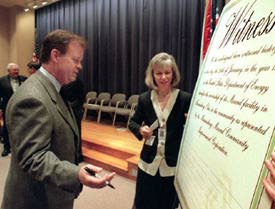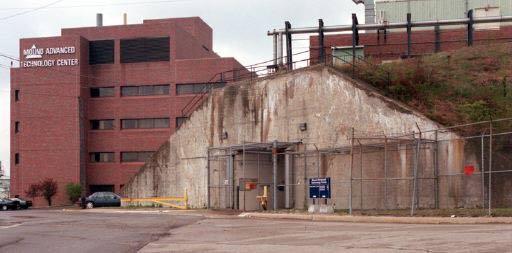History of the Mound Lab:1926 - Thomas and Hochwalt laboratories is established in Dayton (acquired by Monsanto Chemical Co. in 1936).
1942 - Army Gen. Leslie Groves, in charge of the Manhattan Project to develop the atomic bomb, has orders for the Dayton Project in which Monsanto studies properties of radioactive polonium, the neutron source that would start the atom-splitting process. The project is first located at 1601 W. First St., then moves to the Runnymeade Playhouse in Oakwood.
1946 - Miamisburg is selected by the Atomic Energy Commission as site of permanent polonium production plant.
1949 - Polonium processing starts.
1959 - Mound-pioneered radioisotope heat source technology opens era of nuclear-powered spacecraft when President Eisenhower broadcasts radio message using relay satellite powered by a heat source.
1961 - Plutonium-238 production starts.
1968 - First plutonium 238-fueled cardiac pacemaker sources are delivered.
1980 - Plastic bonded explosive is first produced at Mound, and manufacture ofheat source components for General Purpose Heat Source for International SolarPolar space vehicle begins.
1985 - Energy Department's environmental protection program at Mound is criticized by Ohio EPA and attorney general.
1986 - Monsanto announces it will discontinue operating Mound on expiration ofits contract with the federal government on Sept. 30, 1988.
1988 - EG&G Inc. of Wellesley, Mass., is named by Energy Department as new contractor to operate the Mound Plant.
* 1989 - Workers in protective suits dismantle buildings associated with plutonium processingand clean up site. Cost: $146 million. * Dec. 16, 1991 - Energy Secretary James Watkins announces "preferred option" forreconfiguring the nation's nuclear weapons complex that would end production work at Mound. * Jan. 14, 1992 - Dayton Daily News discloses internal Mound study that concludes DOE wouldsave $2 billion over 20 years by consolidating work at Mound instead of closing it. * July 1992 - More than 500 Mound employees take advantage of separation or retirementincentives, cutting Mound's work force so severely that some are asked to delay their departures. * Nov. 18, 1992 - General Accounting Office report says Energy Department's reconfigurationplan is flawed, incomplete and says agency should take another look. * Jan. 19, 1993 - In his last act before leaving office, Energy Secretary James Watkins, submitshis non-nuclear reconfiguration plan to Congress. This frees the agency to begin spendingmoney on plan, including preparations to close Mound, unless Congress acts within 90 days. * March 9, 1993 - New Energy Secretary Hazel O'Leary orders a halt to the plan andcommissions three independent consultants to review it. * May 24, 1993 - The three consultants submit independent reports to O'Leary, each supportingthe reconfiguration plan. * May 27, 1993 - O'Leary affirms the agency's plan to move operations from Mound to plants inSouth Carolina and Missouri.1998 -- The federal government sells the Mound Property for $10 to the Miamisburg Mound Community Improvement Corp. | The plant was owned by the U.S. Department of Energy, but operated by private companies, first Monsanto and later EG&G Inc.
In 1991 the Energy Department announced it would wind down operations at Mound and close the plant by 1995.
On Jan. 26, 1998 the government sold the Mound Plant to the Miamisburg Mound Community Improvement Corp. for $10. The MMCIC, a not-for-profit corporation, was formed in 1994 to develop the property as a technology center.SALE PROVISIONS The sale of the Mound plant began with negotiations in 1997. Its provisions included:
* The Department of Energy agreed to sell the property in the best interest of the United States and to minimize the negativeimpacts of the plant's closure.
* The transaction included real property and improvements, excluding buildings to be razed because ofcontamination. A contingency for buildings associated with the radiothermal generator program was provided until the futureof the mission - the production of power sources for deep-space missions - is determined.
* Property to be transferred as environmental restoration by the government is completed.
* The Department of Energy agreed to hold harmless and defend the MMCIC against future environmental liability.
Rep. Tony Hall prepares to sign a giant document commemorating the transfer of property.
Selected DDN stories:MOUND TO WIND DOWN
PEACE PUTS LAB AT RISK
Published: Tuesday, December 17, 1991 Page: 1A
By: By Tim Gaffney DAYTON DAILY NEWSNO REPRIEVE
MOUND WILL BE CLOSED
Published: Friday, May 28, 1993 Page: 1A
By: By Tom Price WASHINGTON BUREAU MIAMISBURG
COLD WAR LAB SHROUDED IN SECRECY
* Workers at the Mound Lab spoke in code in an undergroundfacility
Published: Sunday, May 4, 1997 Page: 14A
By Dale Dempsey DAYTON DAILY NEWS MOUND
PLANT SHIFTS HANDS
* The city of Miamisburg takes over the 306-acre former weaponstrigger operation today.
Published: Monday, January 26, 1998 Page: 1A
By: By Dale Dempsey Dayton Daily News Click below to generate a search on the Dayton Daily News library for more stories on the Mound Plant. |
|

